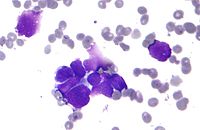
Photo from wikipedia
Purpose This study compared real-world treatment patterns of patients with extensive disease small-cell lung cancer (ED-SCLC) across regions and by platinum resistance/platinum sensitivity (PR/PS) and established if these patterns were… Click to show full abstract
Purpose This study compared real-world treatment patterns of patients with extensive disease small-cell lung cancer (ED-SCLC) across regions and by platinum resistance/platinum sensitivity (PR/PS) and established if these patterns were in line with published guidelines. Patients and methods The data source was the Oncology Monitor, a global database using retrospective medical chart reviews of oncology patients treated with anticancer drugs. All patients diagnosed with ED-SCLC from January 2014 through December 2016 in the US, and in France, Germany, Italy, Spain, and the UK (European Union; EU5), and Japan were included. Results Of 5,849 treated patients, 73.4%, 19.8% and 6.8% received first, second, or third/later lines (1L, 2L, 3L) of therapy, respectively. The most frequent 1L treatment, platinum + etoposide, was significantly more common in the US (87.0%) than in the EU5 (82.1%) or Japan (73.3%) (P<0.05). Platinum + irinotecan was a common 1L treatment in Japan (22.7%) but not in the US (2.0%) or EU5 (0.5%, P<0.0001). Topotecan was the most common 2L treatment in the US and EU5, but amrubicin was the most common in Japan. Among PR patients, 27.3%, 10.8%, and 36.4% received a platinum-based 2L therapy in the US, EU5, and Japan, respectively. Among PS patients, approximately half were not re-challenged with a 2L platinum-based therapy across all regions. Conclusion In contrast to treatment guidelines, a significant proportion of real-world PR patients were re-challenged with a 2L platinum-based therapy, while conversely, many PS patients did not receive platinum-based therapies in 2L. This study highlights a lack of a consistent paradigm for 2L ED-SCLC treatment, limited therapeutic options, and an unmet need among SCLC patients.
Journal Title: Therapeutics and Clinical Risk Management
Year Published: 2019
Link to full text (if available)
Share on Social Media: Sign Up to like & get
recommendations!